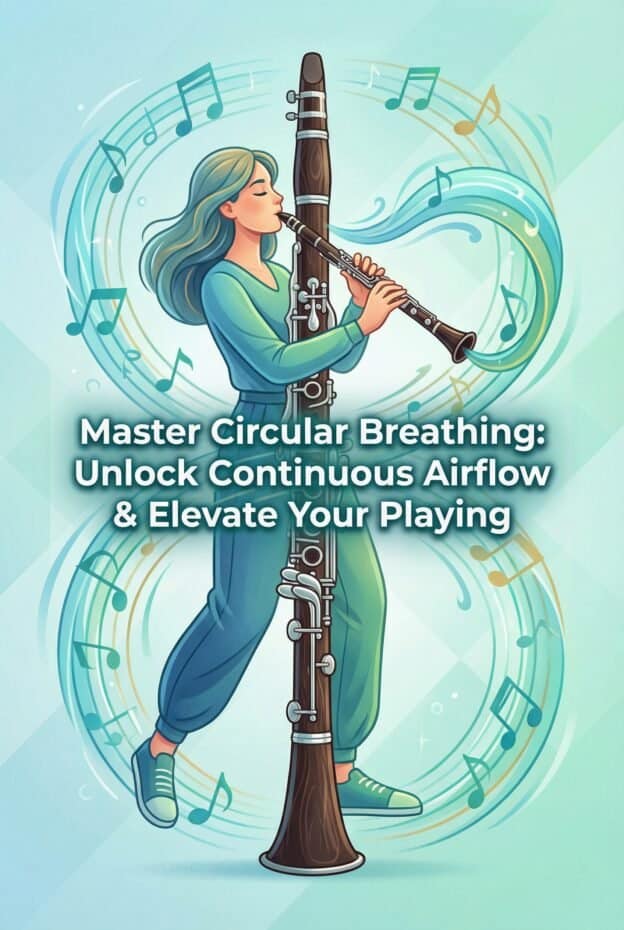Circular breathing is a method of maintaining continuous airflow by storing air in your cheeks while inhaling through your nose. Basic 3 steps: 1) Fill cheeks with air, 2) Use cheek pressure to keep air flowing while you inhale through the nose, 3) Resume lung-based blowing. Practice off the instrument first, then add long tones on a comfortable note like G or A.
What is circular breathing?
Circular breathing is a technique that lets clarinetists keep sound going without a break by briefly switching from lung air to cheek air while inhaling through the nose. You store air in your cheeks, squeeze it out to keep the reed vibrating, then reconnect your lungs. Done correctly, listeners hear a smooth, continuous tone.
On clarinet, circular breathing does not replace healthy diaphragmatic support. Instead, it adds a short backup system that covers the split second when you would normally stop to breathe. Saxophonists, oboists and didgeridoo players use similar methods, but clarinetists must manage a smaller mouthpiece opening and more sensitive pitch response.
Many players first encounter circular breathing through recordings of Richard Stoltzman, Eddie Daniels or classical contemporary works that demand extremely long phrases. Jazz and klezmer clarinetists also use it for dramatic, extended lines. For most players, it is an advanced option, not a daily requirement, but it can be a powerful expressive tool.
Why clarinetists use circular breathing: benefits and musical outcomes
Clarinetists use circular breathing to sustain phrases longer than a normal lungful of air allows. This matters in contemporary classical music, film scores and some jazz solos where a composer or improviser writes phrases that stretch 20 to 40 seconds or more. The technique lets you honor the written line without inserting audible breaths.
Another benefit is dynamic control over long notes. Instead of rushing a phrase because you are running out of air, you can maintain a stable dynamic, then shape crescendos and decrescendos with freedom. This can transform orchestral solos by composers like Messiaen, Copland or John Adams that sit on sustained tones.
Circular breathing also supports extended techniques. Multiphonics, flutter tonguing and extreme soft dynamics often consume air quickly. With cheek air available, you can hold fragile sounds longer, which is especially useful in new music ensembles and electroacoustic settings where the clarinet must match sustained electronic textures.
For improvisers in jazz, klezmer and Balkan traditions, circular breathing opens new phrasing ideas. Instead of planning breaks for air, you can spin long, evolving lines that cross bar lines and harmonic changes. Players like Anat Cohen and Evan Ziporyn show how continuous sound can become part of a personal style.
Anatomy and mechanics: lips, diaphragm and nasal passages
Circular breathing depends on a clear division of labor between different parts of your body. The lips and embouchure seal the mouthpiece and control the reed. The diaphragm and torso muscles supply steady air pressure from the lungs. The nasal passages and soft palate manage the brief inhalation while your cheeks act as a small air reservoir.
The lips must stay stable while the cheeks move. On clarinet, you keep your normal embouchure: lower lip cushioned over the teeth, upper teeth lightly on the mouthpiece, corners firm but not pinched. Only the soft parts of the cheeks puff slightly. If the corners move, the reed loses stability and pitch wobbles.
The diaphragm provides the main airflow whenever you are not actively squeezing cheek air. Think of it as your default engine. When you switch to cheek air, the diaphragm briefly relaxes while you inhale through the nose. After that quick sniff, the diaphragm reengages to take over the airflow again.
The nasal passages and soft palate control the air route. During normal playing, the soft palate lifts so air does not leak through the nose. During circular breathing, you momentarily lower the soft palate enough to allow a quick nasal inhale while the cheeks push air out through the mouth. This coordination is the hardest part for many players.
| Component | Role in circular breathing |
|---|---|
| Lips & embouchure | Maintain seal on mouthpiece, keep reed stable, prevent air leaks at corners |
| Cheeks | Store a small air reserve and gently squeeze to keep sound going during nasal inhale |
| Diaphragm & torso | Provide main airflow before and after cheek phase, regulate pressure and support |
| Nasal passages | Allow rapid inhalation while air exits the mouth, require clear, unobstructed airflow |
| Tongue & soft palate | Shape the oral cavity, separate nasal and oral airflow, assist in smooth transitions |
Simple diagrams can help. A side-view sketch of the head showing cheek air, nasal airflow and tongue position gives students a mental map. Animated sequences that show the switch from lung air to cheek air and back again are especially helpful in studio or classroom settings.
Historical context and notable players (ancient roots to early 20th century onward)
Circular breathing predates the modern clarinet by many centuries. Indigenous Australian didgeridoo players developed it to sustain low drones for ceremonies. Similar techniques appear in traditional music from North Africa, the Middle East and parts of Asia, where double-reed and flute players maintain continuous sound for dance and ritual.
As European wind instruments evolved in the 18th and 19th centuries, circular breathing remained rare in classical contexts. Most repertoire did not require it, and many teachers discouraged it as a novelty. Early 20th century clarinetists in jazz and vaudeville began experimenting with it to impress audiences with seemingly endless phrases.
By the mid 20th century, circular breathing entered contemporary classical music. Composers like Luciano Berio, Karlheinz Stockhausen and Iannis Xenakis wrote long, unbroken lines for clarinet and saxophone that strongly encouraged or practically required circular breathing. New music specialists adopted the technique as part of their core skill set.
Several notable clarinetists helped normalize circular breathing. Players in European new music ensembles, American jazz scenes and conservatory studios shared methods, often borrowing ideas from oboists and saxophonists. Today, recordings and masterclasses by artists in groups like the International Contemporary Ensemble show circular breathing used as a serious musical tool.
Modern cross-genre use spans classical, jazz, film, world and experimental music. Clarinetists collaborate with didgeridoo players, bansuri flutists and Armenian duduk performers, trading circular breathing concepts across traditions. This global exchange has refined teaching methods and made the technique more accessible to students worldwide.
Step-by-step progression to learn circular breathing
A clear progression keeps circular breathing safe and less frustrating. The goal is to separate the skills, then recombine them. Work off the instrument first, then on the mouthpiece and barrel, and only later on full clarinet. Move to the next step only when the previous one feels easy and repeatable.
Step 1: Learn to store and release cheek air
Start without the clarinet. Take a normal breath, puff your cheeks slightly and feel the air pressure. Use your cheek muscles to gently squeeze air out through pursed lips while keeping your jaw and tongue relaxed. Alternate between filling and emptying your cheeks until you can control the flow smoothly for 2 to 3 seconds.
Step 2: Add nasal inhalation while cheeks blow
Next, repeat the cheek-squeeze, but this time inhale through your nose while the cheeks push air out. Aim for a quick, silent sniff. The key is to avoid stopping the outward airflow while you inhale. Practice short cycles: cheeks squeeze for 1 to 2 seconds while you inhale, then relax and breathe normally.
Step 3: Coordinate the switch back to lung air
Now connect the full cycle. Start blowing gently from your lungs through pursed lips. Puff your cheeks while still blowing. Switch to cheek pressure and briefly relax your diaphragm while you inhale through your nose. Then reengage your diaphragm and let lung air take over as the cheeks deflate. Aim for no break in the airstream.
Step 4: Transfer the skill to the mouthpiece and barrel
Place the clarinet mouthpiece and barrel together. Play a comfortable mid-register note, such as written G or A, at a moderate dynamic. Use your normal embouchure. Practice the same cycle: lung air, cheeks fill, cheek squeeze with nasal inhale, then return to lung air. At first, accept a small bump in tone, but aim to keep the reed vibrating.
Step 5: Extend the cycle on full clarinet
Once you can manage a single successful cycle on mouthpiece and barrel, move to the full clarinet. Start with long tones on written G or A in the staff. Use a tuner to monitor pitch. Gradually increase how often you use circular breathing in a single note, but keep the total duration modest, around 10 to 15 seconds at first.
Step 6: Apply circular breathing to simple phrases
After you can sustain a steady tone with one or two circular breathing cycles, try simple scale fragments or arpeggios. Choose comfortable keys like C major or G major. Insert a circular breath on a repeated note or long tone at the end of the phrase. Over time, move the circular breath into the middle of a phrase where it is less obvious.
Practice exercises and drills (glass-of-water straw, cheek-air drills, long tones on G/A, metronome work)
Targeted drills make circular breathing more reliable. Rotate a few short exercises each day rather than grinding one task for a long session. Keep your embouchure relaxed and stop if you feel jaw or throat tension. Regular, low-intensity practice builds coordination better than occasional marathon attempts.
Cheek-air control drill
Sit or stand tall. Take a small breath and puff your cheeks. Use your cheek muscles to push air out through a narrow lip opening, as if whistling. Aim for a steady, quiet hiss for 2 to 3 seconds. Rest, then repeat 10 times. Focus on keeping your jaw and tongue relaxed while only the cheeks move.
Glass-of-water straw drill
Fill a glass halfway with water and place a drinking straw in it. Blow bubbles through the straw using lung air. Once the bubbles are steady, puff your cheeks and switch to cheek pressure while you inhale through your nose. The goal is to keep the bubbles continuous. This visual feedback makes timing errors easy to spot.
Start with short cycles: 1 second of cheek-powered bubbles while inhaling, then 3 to 4 seconds of lung-powered bubbles. Over time, increase the cheek-powered duration to 2 or 3 seconds. Keep your neck and shoulders relaxed. If the bubbles stop, shorten the nasal inhale or reduce cheek pressure.
Long tones on G and A
On the clarinet, begin with written G or A in the staff, mezzo forte. Use a tuner or drone from a piano or tuning app. Sustain the note with a normal breath for 8 to 10 seconds. Then repeat, but insert one circular breathing cycle around the 4 to 5 second mark. Aim to keep pitch and dynamic as stable as possible.
As you improve, lengthen the note to 12 to 16 seconds and add a second circular breathing cycle. Keep the tempo of your inhale consistent. If the note sags or brightens during the switch, reduce cheek movement and focus on steady embouchure pressure on the reed.
Metronome timing drill
Set a metronome to 60 beats per minute. On a comfortable note, plan your circular breath to occur exactly on a specific beat, such as beat 3 of each bar. Use the cheeks to cover one beat of air while you inhale, then return to lung air on the next beat. This trains precise timing and prevents rushed, panicked inhales.
Later, vary the tempo between 50 and 80 bpm and move the circular breath to different beats. This prepares you for real phrases where the best spot for a circular breath might not align with the bar line. Always prioritize musical phrasing over mechanical regularity once you reach repertoire.
Phrase application drill
Choose a simple etude or scale pattern that lasts 8 to 12 seconds. Identify one long note or repeated pitch where a circular breath would be least noticeable. Practice the phrase normally, then add a single circular breath at that point. Record yourself and listen for bumps in tone or pitch. Adjust your timing and cheek pressure until the breath is hard to detect.
Troubleshooting common problems (embouchure stability, leaks, timing, tone quality)
Circular breathing often feels awkward at first. Most problems fall into a few predictable categories: embouchure collapse, air leaks, poor timing and unstable tone. Systematic troubleshooting keeps you from building bad habits or deciding that circular breathing is impossible for you.
Problem: Cheek-only puffing without enough pressure
Some players can puff their cheeks but cannot generate enough pressure to keep the reed vibrating. The sound stops as soon as they switch from lung air to cheek air. This usually means the cheeks are too relaxed or the lip opening is too wide. The fix is controlled cheek-squeeze drills off the instrument.
Practice the cheek-air control drill daily, focusing on a narrow lip opening and a firm, gentle squeeze from the cheek muscles. On the clarinet, try using a slightly softer dynamic during the cheek phase. Over time, the cheeks will learn to provide just enough pressure to maintain the tone for 1 to 2 seconds.
Problem: Embouchure collapse or jaw movement
When players focus on their cheeks, they often let the embouchure loosen or the jaw move. This leads to squeaks, airy tone or dropped pitch. The cure is to isolate embouchure stability. Practice holding a long tone without circular breathing while lightly touching your cheeks with your fingers to feel that the corners stay firm.
If embouchure collapse persists, try a slightly softer reed for circular breathing practice. A very hard reed demands more pressure and makes tiny embouchure shifts more noticeable. Once you can circular breathe reliably on a softer setup, you can gradually return to your usual reed strength if desired.
Problem: Nasal inhalation timing issues
Many players either inhale too slowly through the nose or over-inhale, causing tension. The glass-of-water straw drill is ideal here. It forces you to match the length of your nasal inhale to the amount of cheek air available. Start with very short, quick inhales, then gradually lengthen them as your cheek control improves.
If you feel dizzy, stop immediately and return to normal breathing. Short, efficient nasal inhales are safer and more musical than large, noisy sniffs. Some players benefit from practicing nasal inhales alone, away from the clarinet, focusing on silent, low-tension breaths through both nostrils.
Problem: Pitch and tone instability during the transition
Wobbly pitch or a change in tone color during the switch is common. Often the cheeks move too much or the tongue changes position. Use a tuner and practice very slow circular breathing cycles on G or A with a metronome. Aim for the needle to stay centered during the entire transition.
Think of the cheeks as a small, quiet pump rather than a dramatic puff. Keep the tongue in a stable “ee” or “eh” position and avoid biting harder on the reed. If the tone brightens, you may be over-squeezing. If it dulls, you may be loosening the embouchure. Small adjustments usually fix the problem.
Problem: Air leaks at the corners or nose
Air leaking from the mouth corners or nose reduces pressure and makes circular breathing inefficient. For corner leaks, practice long tones while gently pressing a finger at each corner to remind the muscles to stay firm. For nasal leaks during normal playing, work on lifting the soft palate with silent “ng” and “k” syllables before you add circular breathing.
Instrument setup and maintenance steps for effective circular-breathing practice
Circular breathing magnifies any setup problems on the clarinet. Small leaks or a resistant reed that you can tolerate in normal playing become major obstacles when you rely on brief cheek air. A well-maintained, airtight instrument and comfortable mouthpiece-reed combination make learning the technique far easier.
Reed selection and conditioning
Choose a reed that speaks easily at soft dynamics and in the middle register. Many players find that a slightly softer reed than their usual setup helps during the learning phase. Break in new reeds gradually and use a flat, well-balanced reed that does not require excessive embouchure pressure to vibrate.
Before circular breathing practice, moisten the reed fully and check for chips or warping. A warped reed tip can cause sudden tone dropouts when air pressure changes. Light reed adjustments with sandpaper or a reed knife, if you are experienced, can improve response. Otherwise, switch to a more reliable reed.
Mouthpiece seating and tenon cork fit
Ensure the mouthpiece is fully seated on the barrel and that all tenon corks fit snugly but not excessively tight. Loose joints can leak air, especially when cheek pressure is low. If a joint feels wobbly, have a technician adjust or replace the cork. Use a small amount of cork grease to maintain a smooth, airtight fit.
Key leak checks and pad sealing
Leaks from tone holes or pads make circular breathing much harder. Test for leaks by playing very soft long tones and listening for fuzziness or instability. You can also use a leak light with the clarinet assembled to check for gaps under pads. If you suspect leaks, schedule a professional adjustment to reseat or replace pads.
Pay special attention to the upper joint, where small leaks can affect the critical G and A notes often used for circular breathing practice. Even a minor leak can force you to overcompensate with embouchure pressure, which undermines stability during the cheek-air phase.
Lubricants and mechanism care
Key mechanisms should move quietly and smoothly so you are not distracted by clicks or resistance while focusing on breathing. A technician can apply appropriate key oil and adjust spring tension. Avoid over-oiling at home, which can attract dust and affect pad seating. Clean the exterior of keys regularly with a soft cloth.
Hygiene after cheek and inside-mouth practice
Circular breathing involves more cheek and oral cavity activity than normal playing, which can increase condensation and saliva inside the mouthpiece and barrel. Swab the clarinet thoroughly after practice, especially the upper joint. Rinse or clean your mouthpiece daily with lukewarm water and a soft brush or cloth to prevent buildup.
Good hygiene reduces the risk of unpleasant odors and bacterial growth, which is important if you practice cheek drills frequently. Avoid very sugary drinks or food immediately before circular breathing sessions, as residue can affect reed response and comfort.
Practice plan, milestones and expected player outcomes
A structured plan keeps you moving forward without overloading your embouchure or respiratory system. Short, focused sessions are best. Combine off-instrument drills, on-instrument long tones and occasional phrase work. Track your progress with a timer and simple benchmarks so you can see improvement over weeks and months.
Daily practice structure (10 to 20 minutes)
Spend 3 to 5 minutes on off-instrument cheek and nasal drills, including the straw-in-water exercise. Then devote 5 to 10 minutes to clarinet long tones on G and A, adding one or two circular breathing cycles per note. Finish with 2 to 5 minutes applying the technique to a short phrase or etude excerpt.
Short-term milestones (2 to 4 weeks)
Within a few weeks, most players can aim to sustain a continuous 30 to 60 second airstream off-instrument using cheek-only air cycles, confirmed by the straw bubbles. On clarinet, a realistic early goal is a 10 second uninterrupted long tone with one circular breathing cycle and only minor tone fluctuation.
Medium-term milestones (1 to 3 months)
Over 1 to 3 months of consistent practice, you can expect to extend clarinet long tones to 15 to 20 seconds with two or more circular breathing cycles and stable pitch. You should be able to place circular breaths at specific metronome beats and integrate them into simple scales and etudes without obvious bumps.
Long-term outcomes and repertoire use
With continued work, circular breathing becomes another expressive option rather than a stunt. You will be able to sustain soft multiphonics, match long electronic drones, or spin extended jazz lines without audible breaks. For many clarinetists, the most important outcome is psychological: the freedom to shape phrases without fear of running out of air.
Once the technique feels secure, apply it sparingly and musically. Use it where the score or style truly benefits from continuous sound, not simply to avoid normal, expressive breaths. Teachers can help students decide when circular breathing serves the music and when a well-placed breath is the better musical choice.
Key takeaways
- Circular breathing uses cheek air to keep the clarinet sounding while you take a quick nasal inhale, then returns to normal lung support.
- Off-instrument drills like cheek-squeeze and straw-in-water exercises build coordination before you add the clarinet.
- Stable embouchure, airtight instrument setup and a responsive reed are important for reliable circular breathing.
- Progressive goals, such as a 10 to 20 second continuous long tone, help track improvement and prevent frustration.
- Use circular breathing to serve musical phrasing, not as a constant replacement for natural, expressive breaths.
FAQ
What is circular breathing?
Circular breathing is a technique that lets you maintain continuous sound on the clarinet by briefly switching from lung air to air stored in your cheeks while you inhale through your nose. The cheeks keep the reed vibrating for 1 to 2 seconds while your lungs refill, so the listener hears no break in the tone.
How do I start practicing circular breathing off the instrument?
Begin by learning to puff your cheeks and gently squeeze air out through pursed lips while keeping your jaw relaxed. Then add a quick nasal inhale while the cheeks continue to push air out. The glass-of-water straw drill, where you keep bubbles going during the nasal inhale, is one of the most effective starting exercises.
What are safe practice progressions to add circular breathing to clarinet playing?
Start with off-instrument cheek and straw drills, then move to mouthpiece and barrel long tones on a comfortable pitch. Once that feels stable, practice long tones on full clarinet, usually on written G or A, adding a single circular breathing cycle. Only after that should you apply the technique to simple phrases and, later, to repertoire.
Why does my tone wobble when I try circular breathing and how do I fix it?
Tone wobble usually comes from embouchure movement, excessive cheek motion or tongue shifts during the switch. Use a tuner and metronome to practice very slow circular breathing cycles on mid-register notes. Focus on keeping the lips and jaw steady, minimizing cheek movement, and maintaining a consistent tongue position while you change air sources.
Are there historical examples of clarinetists using circular breathing?
Yes. Circular breathing has roots in instruments like the didgeridoo and has been adopted by clarinetists in jazz, contemporary classical and world music contexts. Throughout the 20th century, new music specialists and improvisers used it to sustain long phrases, and archival accounts show early experiments by clarinetists in European music halls and café concerts.







